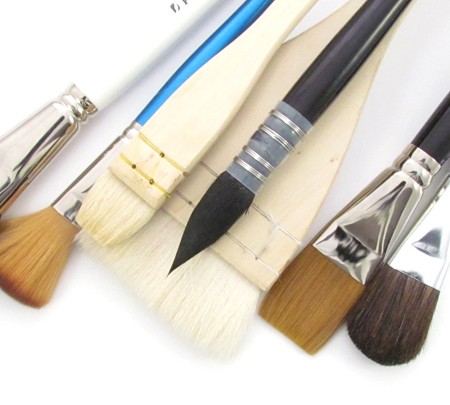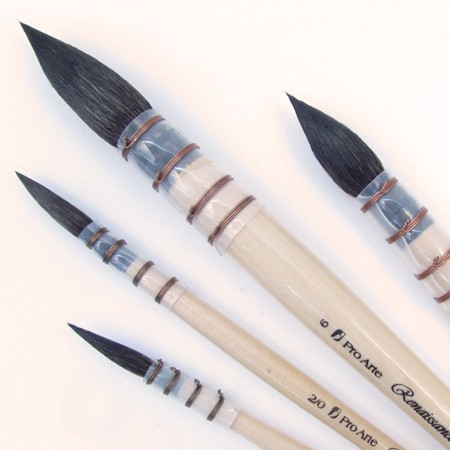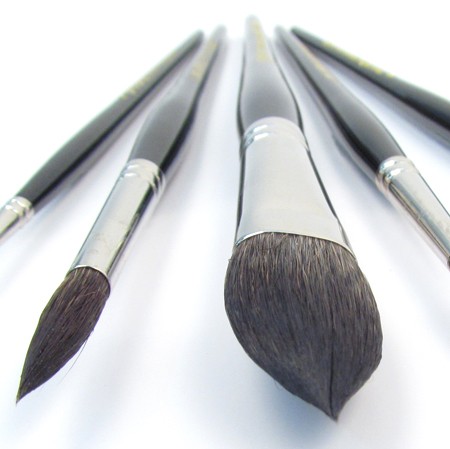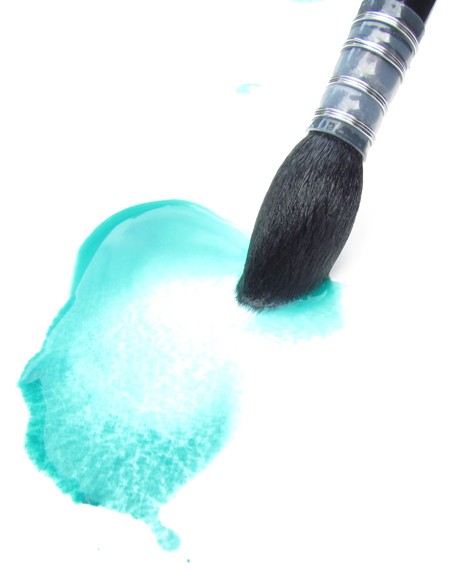An Introduction to Mop or Wash Brushes
Click here to Shop Pointed Mop Wash Brushes
Click here to Shop Round Mop Brushes
Click here to Shop Ron Ranson Hake Brushes
A mop brush is a large, round wash brush most commonly used to cover large areas in watercolour or other diluted or liquid colour whilst a wash brush is a large flat brush that does a similar job.

A selection of mops and wash brushes
The best hair for carrying large amounts of water is a natural hair. However, the cost of hair like Kolinsky would put the price of a large wash brush out of the reach of most artists and so other natural hair such as black squirrel, petit gris, and goat is favoured as these hairs hold water brilliantly and are much more affordable.
Most brush manufactures will also produce their own synthetic versions which will comprise of a blend of fibre types to mimic the properties of natural hair.

Quill-bound Pro Arte Renaissance Squirrel Mops
Mop brushes come in a selection of different styles. The standard, cheaper mops are slightly rounded at the tip but otherwise unshaped whilst the shaped mops will give finer mark-making options as well as washes.
These shaped mops are either round or filbert-like – the latter known as cat’s tongue – and formed into a point at the tip and the shaped rounds are very often constructed in the traditional form of a quill-bound brush instead of with a metal ferrule.

An ‘unshaped’ domed mop brush

A pointed mop

Seen here with smaller rounds is a Kazan Squirrel in the flatter, pointed mop shape
Being all about carrying lots of colour, mops may not have much spring or snap to them so they suit a looser painting style where colour is laid down in washes or with more flourished mark-making made with movements of the wrist.

A Pro Arte Student Renaissance Mop heavy with watercolour
Without the ‘spring’ of sable and some synthetic fibres, a shaped mop will hold in the direction it was last dragged from across a surface. With practice, you can learn to roll the brush and apply different pressures when making marks so as to overcome this.

Varying the pressure applied to the surface achieves different marks
Artists that require more responsiveness in order to make very controlled marks, for botanical illustration for instance, may find them too unruly.

Even incredibly fine, thin lines when just the point is used
When dry, mops can look bushy and unshaped. This is quite normal and, once loaded with water, will immediately ‘clump’ back into their pointed shape. Quill-bound mops will also have straggly hairs where the brush head meets the quill. Again, this is normal and will not affect the performance of the brush.
Always ensure they are dry before storing and as with all brushes, but particularly in the case of mops, never leave them in water.

Straggly hairs on quill-bound mops will not affect performance
Large flat wash brushes have less mark-making options but will produce a beautifully effortless coverage of large areas which is great for landscapes or providing background colour. The most popular come in synthetic and goat hair with the traditionally constructed goat hair type called a hake.

A large area covered in one effortless stroke with a goat hake brush
